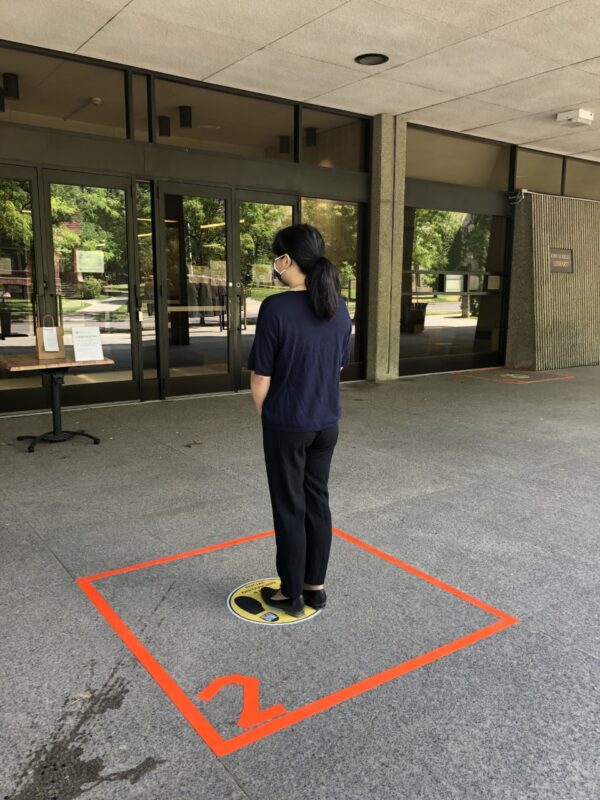David Rubenstein graduated with an Honours Bachelor of Science with High Distinction in Biochemistry and Physiology. With aspirations to join the medical vocation, he has been accepted into the LMP MSc program for 2022.
“SMC is home” is a phrase that is often heard being used by visitors to the grounds of SMC/halls of Brennan, for those fortunate nesters who have lived in residence, and those flocks of commuters that travel long and far just to hang out in the COOP.
For me, “SMC is Home” holds meaning because this has been an important place that has aided my growth into the person that I am today. It has been my stepping stone in my academic career, It has been my nest, the place where I have met many friends, faced challenges, and accomplished many feats.
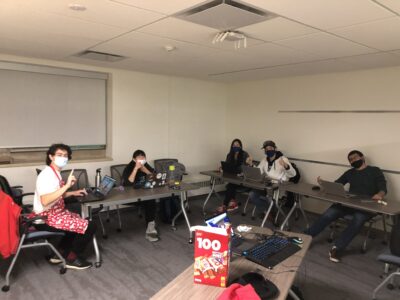
One of the achievements I am most proud of is the creation of a Minecraft club during the beginning of the pandemic that worked towards fostering community through a collaborative project of recreating a virtual 1-to-1 scale of our St. Mike’s Campus on our public server.
To give a little background about how this all came about: it all started when I lived in the residence buildings during my first two years of undergrad, between 2018 to 2020 — the pandemic year.
During my first year, I was a proud and engaging member of Mallon House located on Elmsley Second. The Mallon boys had a strong community thanks to our valiant leader and Don Big Mike. But as second year came around, community was a little bit harder to come by for me.
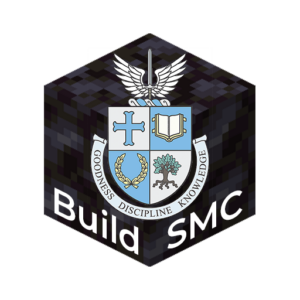
My dorm room during second year was located in the north wing of Sorbara First, which was uniquely designed to have a walkway in between the north and south wings such that they were not physically connected. This most definitely made connecting with my brothers in the south more difficult, but it also turned our wing into a nice secluded little patch of paradise with very little foot traffic. A perfect location to ride out the self-isolation during the Covid-19 pandemic in March 2020. But even before this, it would also get a bit lonely sometimes to be so close yet so far away from the rest of the floor.
In September 2019, I was elected president of the Sorbara First House Council, and for one of my first initiatives, I helped to establish and promote multiplayer video and board game nights as an attempt to strengthen the community within our floor and with our sister floor (Sorbara Fourth, Wall House? – I forgot the house name sorry). We played games like Scribblio, Codenames, AmongUs, and my personal favorite: Minecraft.
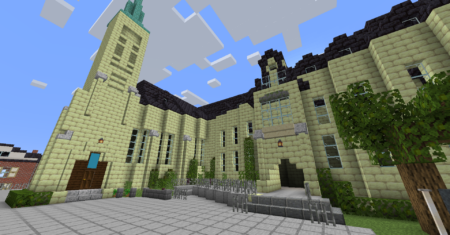
For those who are unfamiliar, Minecraft is a video game where players can make or break apart various kinds of blocks in a three-dimensional world. With a distinctly simple yet chunky aesthetic, this game offers two game modes: Survival- where players collect food and resources to explore and survive the world and its many dangers. And Creative- a sandbox mode where players are given all resources and are free to create anything they want to.
Minecraft also offers multiplayer access, so players can interact on the same world or server and complete tasks together. This was a perfect platform for us because a good chunk of my generation had grown up playing Minecraft, you could hop on any time and just have fun.
With my friend Jake Lunn’s help, we created the Sorbara First server and invited everyone to play on. Throughout the school year, we would all sit around in the common room or in someone’s dorm room and build our dream houses, go on epic quests, do harmless pranks on each other and just have fun. (shout out to the madlads: Borair, Sam, Kamil, Cedric, Vansh, and Jake). But then as March of 2020 came creeping in, so did the self-isolation protocols. While our in-person gathering came to a halt, we continued to use the digital worlds of video games like Minecraft to socialize and play together.
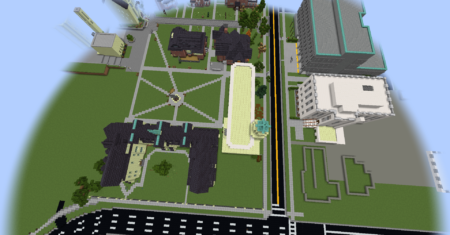
One night, as I sat staring boredly at the walls of my 11’ x 14’ room (yes, I had reached a point of boredom where I decided to measure the dimensions of my dorm using just a pencil and a 12’ ruler) I decided that it would be fun to recreate my dorm room in our minecraft server as a way to remember where I spent self-isolation during these difficult times. My fellow Sorbara minecrafters loved the idea! And joined me on this personal project and built their rooms as well as it was a fun and unique activity.
We let our creativity soar high and wide, and what started out from just building rooms, extended to building our entire floor, and eventually to the entirety of Sorbara Hall. It was at this moment that I proposed an idea. What if we built our entire UofT campus?
Of course I was being extremely ambitious, but this question led me and a small group of friends (Keanu, Gordon, Matthew, and Mateo) to create a new SMC club in the summer of 2020 called: BuildSMC. Our goal was simple: to foster community and work on this project of building our St. Mike’s campus in Minecraft.
We created a club Minecraft server free to join for any SMC or UofT student and worked on this project all summer. By September 2020, we had already built all of Sorbara Hall, every historic house on Elmsley way, and had laid down the foundations for Brennan Hall, Elmsley Hall, the Queens park buildings, and Kelly Library.
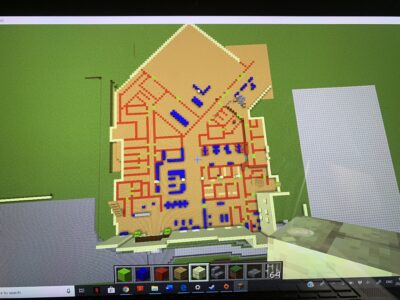
Because Minecraft blocks use the metric system and have been designed to be one cubic meter, we decided to create as accurate a model of our campus as possible. For measurements, we used various online tools to aid our build. Such as using Google Maps features like Measure Distance to determine the dimensions of buildings, locations, parks, and the Google Streetview feature to look at building exterior designs. For building interiors, we used apps like FindMyClassroom, old SMC floor plans that were accessible from the library, and the emergency exit displays that can be found in almost every building. Naturally, we also took creative liberties with spaces that we could not see using any of these methods.
For the actual building process, every block that is on the server has been placed either manually, or generated en masse using commands and game mods like worldedit. We had dedicated building times at least once a week where we would hop on a call on Discord and work on the build project together.
Looking back, it has been well over two years since the initiation of the project and the establishment of the club. I am proud to say that since the start of 2022, we have now built (almost) every SMC road and structure, and have started working on phase II of our project: building all of UofT. We have already laid down the entire roadway network of the St. George campus — every major car road between Bloor, College, Bay and Spadina. (You can literally walk on our campus recreation through the virtual world!) But aside from these accomplishments, I am most proud of the little community that has been created simply through the mutual love, curiosity and creativity that we all share for Minecraft.
At this time, most of us who were involved have now moved on to different things, especially as we graduate. The project is currently waiting on our server for the next generation to pick it up and continue it to the next stages of its development. So please! If you are interested feel free to reach out to me!
But I must say, as I had returned to St. Mike’s with my family by my side on convocation day – to walk across that podium with the degree that I worked so hard over the last four years to earn and accept the recognition that I have been given. I can truly say, SMC is – and always will be – Home.
It is thanks to St. Michael’s Annual Fund and Leadership donors that our students can work on student driven projects like Project Build SMC. The Annual Fund supports the maintenance of student spaces, library and computer network resources and other student services to enhance life on campus.
Read other InsightOut posts.
Maya Omar Choudhry is a first-year student at the University of St. Michael’s College, double majoring in Criminology and Sociolegal Studies as well as Drama Studies. She is a current member of the University of Toronto’s Pi Beta Phi Sorority. Being highly athletic from a young age, she is also part of the U of T’s TriathlonClub.
As a Pakistani Muslim, I was speechless and totally overwhelmed with emotion when I received an email from the St. Michael’s community announcing that they had set up a Ramadan meal accommodation program for the minority Muslim students living in residence. This revelation was like a breath of fresh air and seriously sounded like music to my ears. I felt an incredible self of relief as I had been pondering upon what my first Ramadan in a non-Muslim country would be like, away from my family.
This may sound like a small gesture, but for us Muslim students this extremely thoughtful and highly considerate gesture was as good as gold. This kind act was such an inspiration that it reflected that there are no boundaries when it comes to helping others and that too during this blessed month.

Monday, May 2, 2022 – 6:00 AM
For those of you who are not familiar with Ramadan, it is the most sacred and holiest month, which falls ninth under the Islamic calendar. During the month of Ramadan, it is believed that on the night of Layat-Al-Qadr, also known as The Night of Power, Allah sent angel Jibraeel to our beloved Prophet Mohanned (pbuh) to reveal the Qur’an, the holy book of Islam.
The Prophet Mohammed reportedly said, “When the month of Ramadan starts, the gates of heaven are opened and the gates of hell are closed and the devils are chained.” It is a month to reflect on what it means to be a true Muslim, a time to indulge in spiritual discipline and build a stronger bond with Allah. It is time for repenting from the depths of your heart by asking Allah Almighty for forgiveness so that you will never repeat a certain mistake or misdeed again, because no matter how big a person’s sin is, it is not bigger than Allah’s Mercy.
For Muslims, this period of the month represents a time of self-reflection, patience, and self-control. Ramadan allows one to practise self-reflection by seeking forgiveness. According to the Islamic faith, asking for repentance entails accepting responsibility for an act you feel apologetic about. Fasting teaches us to be patient as one refrains from eating or drinking from sunrise till sunset. The practice of keeping a fast allows us to be grateful for the food we get to eat daily because it reminds us of the less fortunate people, reinforcing us to be more thankful. Thus, empathy for the unfortunate ones encourages us to give Zakat (charity) or food to help them.
Fasting is one of the pillars of Islam. The rules of fasting during Ramadan are quite simple. Firstly, nothing should enter your body. One should refrain from bad habits as well as abstain from the consumption of drinks and all kinds of foods from dawn until sunset. Muslims usually have a meal before dawn also known as Sehri and break their fast after the sun sets. This is called Iftari. In Canada the fasts are more challenging as the hours of fasting are longer especially in Canada’s north, where the fasting day is as long as 19 hours.
With Ramadan comes increased spiritual worship as Muslims consciously try to practise living according to Islamic principles on a daily basis, with the focus on the hereafter instead of the materialism of the worldly life, which means embracing honesty, empathy, kindness, and modesty.
So, when I awoke to the literal feast the university had arranged for us with a vast variety of foods and drinks, it was a rather emotional moment. I, for one, felt valued and respected. Sehri did not feel so alone as it sometimes does now that I am far from my family, especially as Ramadan is when families sit down together during Sehri and Iftari. Moreover, it was so convenient thanks to St. Michael’s to have my Sehri on campus because I did not have to worry about getting groceries or going out at four in the morning for Sehri.
Another thing I would like to mention is how I noticed the new changes that were made weekly to improve the program. During the first week, we were provided with a huge variety of assorted fresh fruits, cereals, pastries, yogurts, and juices. The second week was followed by the addition of a toaster and a microwave. Honestly, it just got better week by week, which left the third week to consist of the addition of freshly pre-packed warm dishes. These small acts of kindness made me feel so grateful because it shows that the community wholeheartedly cares and is checking up on us every week by improving the food accommodations.
I can proudly say that University of St. Michael’s College is a home away from home. I felt the university made an effort to get to know us and our beliefs. I am thankful, as I am sure are the rest of U of T’s Muslim students, for this step the university has taken towards us. I can confidently say that U of T never fails to hit the mark when it comes to fulfilling the needs and requirements of its students who observe religious practices.
Read other InsightOut posts.
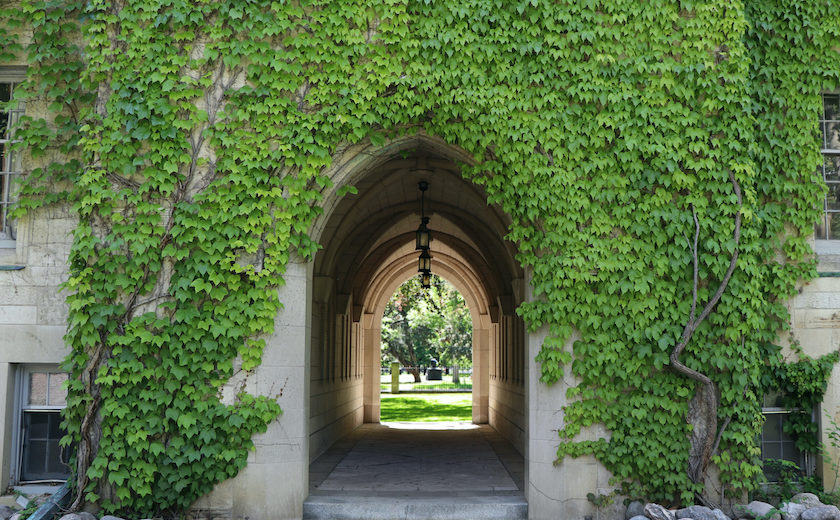
A new initiative will bring young scholars into the St. Michael’s community this fall, fostering their research and building their professional connections while enriching the campus with their expertise and enthusiasm.
The St. Michael’s College Junior Fellowship Program is designed for professional students (including those who study law and medicine), graduate students, and advanced-degree graduates who have a connection to the University of Toronto and an interest in participating in, and contributing to, the life of St. Michael’s. Junior Fellows will propose their own unique contributions, which can range from creating and facilitating topical reading groups and working groups, to participating in programming for St. Michael’s students and students enrolled in St. Michael’s sponsored programs, to creating new opportunities to enhance collegiate life in other areas. Perks include an annual research stipend, full library privileges, faculty mentorship and professional development opportunities, and access to the Faculty Dining Room and common rooms.
“I think this will foster a thriving, vibrant community of young scholars who are going to connect with each other and with members of the college—its students, faculty, and senior fellows—in ways that are distinctive to the intellectual interests and values of St. Michael’s as an institution,” says Dr. Stephen Tardif, Assistant Professor, Teaching Stream, of the Christianity and Culture Program.
Tardif says that the new program is comparable to junior fellowship programs at other U of T Colleges such as Victoria College, which in a typical year will host 10 to 20 participants. He expects a similar number of fellows in St. Michael’s program.
In addition to fostering community among young scholars, Tardif expects the program to fuel exciting research in subject areas that are distinctive to the intellectual interests and values of St. Michael’s as an institution. “Gathering together will be a process of intellectual discovery. We’re very excited to see how these kinds of connections can facilitate [the junior fellows’] own research, and how our own faculty and fellows might offer them mentorship and intellectual community,” he says.
Taking an active, shaping role in the development of the next generation of scholars is a particular benefit for current faculty in St. Michael’s sponsored programs because their teaching and mentorship is usually focused on undergraduate students. Providing mentorship to and fostering the research of graduate students creates opportunities to “shape the next generation of scholars,” Tardif says.
The deadline for applications to the St. Michael’s College Junior Fellowship Program for the 2021-2022 academic year is August 1, 2021.
Kelly Library patrons can once again hold physical books from the collection in their hands through a new curbside pickup service.
To support the community’s access to materials while also following public health guidelines, library staff can now accept requests from any patron with a valid UTORid through the UTL catalogue for select physical items in the collection that are not held in the Hathitrust Digital Library. These items are then made available for pickup in a safe and appropriately distanced manner.
“Curbside pickup of materials is an exciting move toward reinstatement of our services and in our ongoing effort to support students and faculty,” Chief Librarian Sheril Hook says. “As we launch and evolve the service, the health and safety of our community is a top priority, with safety precautions implemented at each step of the borrowing process, following guidelines outlined by the University of Toronto Libraries and Toronto’s public health authorities.”
After they receive a pickup notice from library staff, patrons can visit to pick up materials between 9 a.m. and 4 p.m. Monday to Friday in front of the library. Visitors using the service will queue in a waiting area and then proceed to approach the window near the book return slot under the awning of the library, and boxes marked with tape on the ground will indicate where patrons should wait in order to maintain a safe physical distance. The library will not be open to visitors indoors, and all pickups will be handled outside. Patrons who cannot come in person can place a note in the catalogue request for their friends or family members to pick up materials for them.
The service makes available materials that have otherwise been inaccessible to patrons in any format during the pandemic. In addition to the physical items now available for curbside pickup, patrons can request a PDF scan of a single book chapter or journal article from the library’s circulating collection not available through Hathitrust. Physical items being lent out will be due back by August 31, 2020, although this date may be updated as plans continue to change during closures.
The Kelly Library has made available full instructions for using the service, including health and safety guidelines and FAQs.

